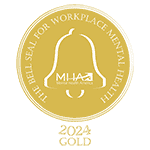This is just a tiny glimpse of the data available to CivicScience clients. Discover more data.
This week brought major seesaw developments in international trade. On April 2, President Trump enacted a 10% universal tariff on all imported goods starting April 5—dubbed “Liberation Day”—along with additional country-specific tariffs. Key imports such as pharmaceuticals and automobiles were included. Both China and the European Union have announced retaliatory measures of their own in response. Amid growing market volatility, President Trump announced on April 9 a 90-day pause on some of the newly imposed tariffs—but simultaneously increased tariffs on Chinese imports to 125%. The ongoing trade dispute coincides with a recent decline in consumer financial well-being.
While the situation remains in flux, data suggest that some consumers are delaying purchases in anticipation of rising prices, while others are accelerating spending. CivicScience data show that 15% of U.S. adults say they’re most likely to increase purchases of goods that could be affected by new tariffs before they make an impact—slightly fewer than those who say they’re more likely to delay (16%). Meanwhile, 37% report no plans to change their buying behavior.
Middle-income households with an expected annual income of $50K-$100K are most likely accelerating their purchases due to potential tariff-driven price increases, whereas higher-income households with an expected annual income over $100K are the most likely to delay their purchases altogether. Middle and low income households are also most likely to wait and see what happens with prices.

Answer our Poll: How worried are you about the impact of the new tariffs on your household expenses?
What are consumers purchasing now in hopes of beating out tariff-driven hikes? Here’s a closer look at the top categories showing preemptive purchasing as potential tariff impacts loom:
- Food and beverages (67%) show the highest acceleration rate across all categories, indicating consumers could be most concerned about tariff impacts on essential goods.
- Apparel and footwear (53%) and pet supplies (45%) follow as the second and third highest categories overall, suggesting significant consumer concern about price increases for both personal and pet care items.
- Among durable goods, automobiles/auto parts (40%) and kitchenware/cookware (40%) show identical and highest acceleration rates, followed by consumer electronics (38%).
- School supplies show the lowest acceleration rate (21%) across all categories, while furniture (26%), fitness equipment (28%), and home improvement materials (28%) are also among the lowest, suggesting less immediate consumer concern about tariff impacts on these products.
Unsurprisingly, when comparing discretionary versus essential items, consumers consistently show higher concern for essentials—food/beverages, pet supplies, and medications all rank higher than most discretionary and lower-priority categories like toys/games, furniture, and school supplies. That said, at least one-fifth of those speeding up their purchases report cutting back on each category.

Use this Data: CivicScience clients have access to real-time insights like these to help them gain and retain customers in today’s ever-changing, uncertain environment.
While uncertainty surrounding tariffs remains, it’s evident that consumers are already adjusting their spending habits, in response to potential price hikes. For brands and retailers, identifying what consumers prioritize most is crucial. Understanding which categories are most vulnerable to tariff impacts – largely essentials – will allow them to adapt their strategies, manage inventory, and anticipate consumer demand more effectively, ensuring they remain responsive in an unpredictable market.








